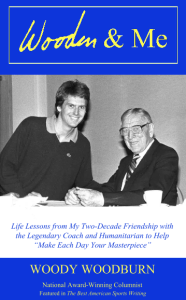My new memoir WOODEN & ME is available here at Amazon
* * *
Imperfection Can Be Beautiful
“How long does it take you to write a column?”
It is a question I am often asked when speaking to a classroom of kids or a service group of adults or book club. I really have no good answer other than, “About twice as long as it should because I’m a painfully slow writer – but usually not long enough because my deadline seems to arrive before I’m completely satisfied.”

Navajo blankets often have a “spirit outlet” imperfection purposely woven into them to add even more beauty.
This is as true now with a week to turn in a column as it was in the press box with as little as 20 minutes to write from game’s end to deadline. Indeed, I have found truth in Leonardo da Vinci’s observation: “Art is never finished, only abandoned.”
And yet historians suggest da Vinci had a difficult time abandoning his art fully, as it is believed he worked on the Mona Lisa, off and on, for possibly 16 years, including 12 years on the lips.
Thank goodness for deadlines that force a writer to abandon his or her art. Indeed, a deadline is penicillin for the bacteria writer’s blockitis and paralysis by perfectionism.
“Perfectionism is the enemy of creation, as extreme self-solitude is the enemy of well-being,” said the prolific writer John Updike.
Volitare was more succinct, noting: “The perfect is the enemy of the good.”
Nonetheless, I still believe that in writing – as in most endeavors – time and effort are the ally of the good becoming better. Certainly I think a column I spend many hours on, and rewrite and polish and rewrite, will rise above one I bang out in a couple hours.
“Aim at perfection in everything, though in most things it is unattainable,” advised Lord Chesterfield. “However, they who aim at it, and persevere, will come much nearer to it than those whose laziness and despondency make them give it up as unattainable.”
John Wooden put it similarly: “Perfection is an impossibility, but striving for perfection is not. Do the best you can. That is what counts.”
I recently learned that the Shakers, renowned for their furniture design and craftsmanship, had their own vaccine for Type-A perfectionism – they deliberately introduced a “mistake” into the things they made in order to show that man should not aspire to the perfection of God. Flawed, they believed, could be ideal.
Perhaps many of us can take a lesson here from the Shakers. Maybe we don’t figuratively need a gold star and “Perfect” written in red ink atop the page of everything we undertake. Maybe instead we need to be proud of doing our best.
Maybe we need to see our creativity when we draw outside the lines. Maybe we need to embrace the effort when we don’t set a new PR in a 5K or marathon.
Maybe we need to ignore advertising that makes us believe that only a wrinkle-free, gray-free, fill-in-the-blank-free appearance is beauty perfection.
Similar to the Shakers, the Navajos purposely weave a single imperfection into their handmade blankets. To their eyes this makes the blankets more, not less, beautiful.
In his terrific book, “Blood and Thunder: The Epic Story of Kit Carson and the Conquest of the American West,” author Hamptom Sides elaborates on this mindset:
“Navajos hated to complete anything – whether it was a basket, a blanket, a song, or a story. They never wanted their artifacts to be too perfect, or too close-ended, for a definitive ending cramped the spirit of the creator and sapped the life from the art. So they left little gaps and imperfections, deliberate lacunae that kept things alive for another day.
“Even today Navajo blankets often have a faint imperfection designed to let the creation breathe – a thin line that originates from the center and extends all the way to the edge, sometimes with a single thread dangling from its border. Tellingly, the Navajos call the intentional flaw the ‘spirit outlet.’ ”
Henceforth, I will keep the Shakers and Navajos in mind with my writing – and other undertakings – and embrace imperfections. However, I won’t intentionally weave a mistake into my columns as I am confident my “spirit outlet” will occur on its own.
* * *
Woody Woodburn writes a weekly column for The Ventura County Star and can be contacted at WoodyWriter@gmail.com.
 Check out my new memoir WOODEN & ME: Life Lessons from My Two-Decade Friendship with the Legendary Coach and Humanitarian to Help “Make Each Day Your Masterpiece”
Check out my new memoir WOODEN & ME: Life Lessons from My Two-Decade Friendship with the Legendary Coach and Humanitarian to Help “Make Each Day Your Masterpiece”
- Personalized signed copies are available at WoodyWoodburn.com
- Unsigned paperbacks or Kindle ebook can be purchased here at Amazon
